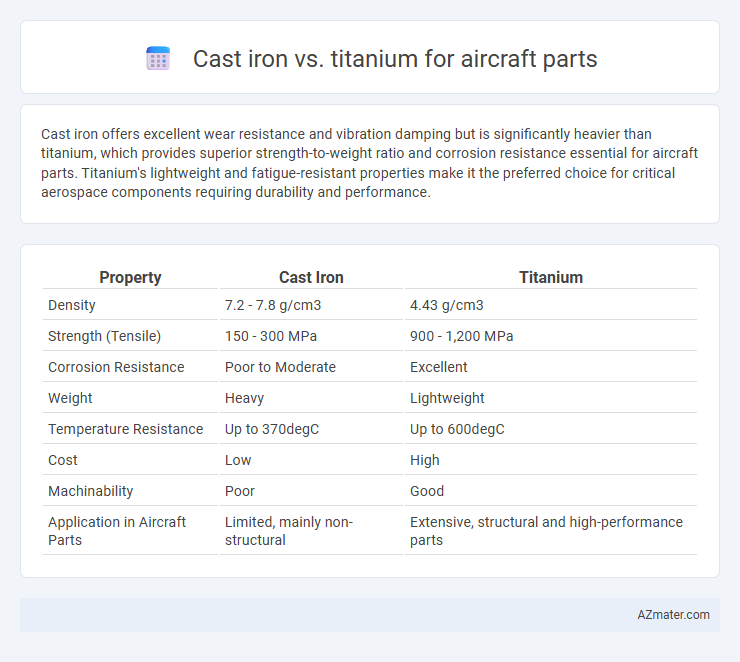Cast iron offers excellent wear resistance and vibration damping but is significantly heavier than titanium, which provides superior strength-to-weight ratio and corrosion resistance essential for aircraft parts. Titanium's lightweight and fatigue-resistant properties make it the preferred choice for critical aerospace components requiring durability and performance.
Table of Comparison
| Property | Cast Iron | Titanium |
|---|---|---|
| Density | 7.2 - 7.8 g/cm3 | 4.43 g/cm3 |
| Strength (Tensile) | 150 - 300 MPa | 900 - 1,200 MPa |
| Corrosion Resistance | Poor to Moderate | Excellent |
| Weight | Heavy | Lightweight |
| Temperature Resistance | Up to 370degC | Up to 600degC |
| Cost | Low | High |
| Machinability | Poor | Good |
| Application in Aircraft Parts | Limited, mainly non-structural | Extensive, structural and high-performance parts |
Introduction to Aircraft Material Selection
Aircraft material selection prioritizes strength-to-weight ratio, corrosion resistance, and fatigue durability. Cast iron offers excellent compressive strength and wear resistance but is heavy and prone to brittleness, limiting its use in critical aircraft components. Titanium provides superior strength, lightweight properties, and exceptional corrosion resistance, making it a preferred choice for high-performance aircraft parts.
Overview of Cast Iron in Aerospace Engineering
Cast iron, characterized by its high strength and excellent vibration damping properties, is occasionally used in aerospace engineering for specific aircraft parts requiring wear resistance and thermal stability. Its heavy weight and lower corrosion resistance compared to titanium limit its application in modern aerospace structures, where weight reduction and durability are critical. Cast iron components are typically found in non-critical areas such as engine mounts or tooling rather than in primary airframe structures.
Titanium: Properties and Applications in Aviation
Titanium offers exceptional strength-to-weight ratio, corrosion resistance, and high-temperature performance, making it ideal for critical aircraft components such as engine parts, airframes, and landing gear. Its lightweight nature reduces overall aircraft weight, improving fuel efficiency and flight performance compared to heavier cast iron parts. The metal's durability and resistance to fatigue contribute to enhanced safety and longer service life in aviation applications.
Weight Comparison: Cast Iron vs Titanium
Titanium offers a significant weight advantage over cast iron, with a density of approximately 4.5 g/cm3 compared to cast iron's 7.2 g/cm3, making titanium nearly 40% lighter. This reduced weight is critical in aircraft parts to improve fuel efficiency and performance by minimizing overall aircraft mass. Despite cast iron's strength and durability, titanium's excellent strength-to-weight ratio makes it the preferred material for weight-sensitive aerospace components.
Strength and Durability Differences
Titanium offers superior strength-to-weight ratio and exceptional corrosion resistance compared to cast iron, making it ideal for critical aircraft components exposed to stress and environmental factors. Cast iron, while durable and cost-effective, is significantly heavier and more brittle, limiting its use in aerospace applications where weight reduction and impact resistance are crucial. The high fatigue strength and fracture toughness of titanium enhance the longevity and safety of aircraft parts under dynamic loads and extreme conditions.
Corrosion Resistance in Aircraft Environments
Titanium exhibits superior corrosion resistance compared to cast iron in harsh aircraft environments, including exposure to saltwater, humidity, and varying temperatures. Cast iron is prone to rust and degradation when exposed to moisture and salty air, which can compromise structural integrity over time. Aircraft components benefit from titanium's lightweight and high resistance to oxidation, ensuring enhanced durability and longevity in corrosive aviation conditions.
Cost Implications: Cast Iron vs Titanium
Cast iron offers significantly lower upfront material costs compared to titanium, making it a cost-effective option for manufacturing less critical aircraft parts. Titanium, despite its high initial expense, provides superior strength-to-weight ratio and corrosion resistance, resulting in long-term savings through improved fuel efficiency and reduced maintenance costs. When evaluating total lifecycle expenses, titanium's durability often justifies its premium price in aerospace applications.
Machinability and Manufacturing Processes
Cast iron offers excellent machinability due to its graphite content, which acts as a natural lubricant, reducing tool wear and allowing for faster machining speeds in aircraft part manufacturing. Titanium presents significant challenges in machining because of its low thermal conductivity and high strength, necessitating specialized cutting tools and slower processes to prevent work hardening and tool degradation. Manufacturing processes involving cast iron are generally more cost-effective and faster, while titanium requires advanced techniques such as precision milling and additive manufacturing to meet aerospace standards for weight and corrosion resistance.
Real-World Applications in Aircraft Components
Cast iron is rarely used in modern aircraft components due to its high weight and brittleness, limiting its application primarily to older or non-critical parts such as engine mounts or brackets. Titanium, favored for its exceptional strength-to-weight ratio, corrosion resistance, and fatigue durability, is widely employed in critical aircraft components including engine parts, landing gear, and structural frames to enhance performance and reduce overall aircraft weight. The real-world application of titanium in aerospace enables improved fuel efficiency and extended lifespan of components compared to traditional materials like cast iron.
Future Trends in Aerospace Materials
Titanium alloys are increasingly favored in aerospace due to their superior strength-to-weight ratio, corrosion resistance, and ability to withstand extreme temperatures, making them ideal for high-performance aircraft components. Cast iron, while traditionally used for heavy-duty parts, is less common in modern aerospace applications due to its higher density and lower fatigue resistance. Future trends indicate a strong shift toward lightweight, high-strength materials like titanium alloys and advanced composites to improve fuel efficiency and performance in aircraft design.

Infographic: Cast iron vs Titanium for Aircraft part
 azmater.com
azmater.com